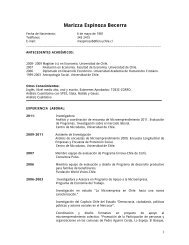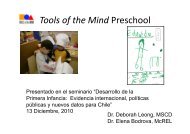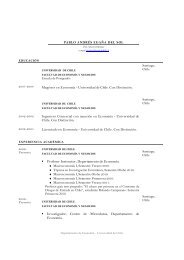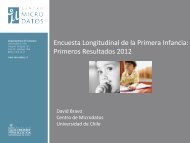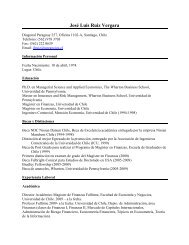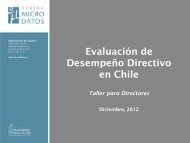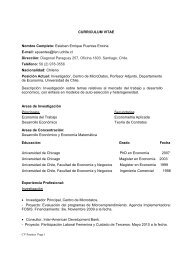Introducción a Series de Tiempo Univariadas - Centro Microdatos
Introducción a Series de Tiempo Univariadas - Centro Microdatos
Introducción a Series de Tiempo Univariadas - Centro Microdatos
You also want an ePaper? Increase the reach of your titles
YUMPU automatically turns print PDFs into web optimized ePapers that Google loves.
020000 40000 60000Introducción a <strong>Series</strong> <strong>de</strong> <strong>Tiempo</strong> <strong>Univariadas</strong>December 31, 2010tssmooth exp sa_s5=sa, forecast(24)computing optimal exponential coefficient (0,1)optimal exponential coefficient = 0.8258sum-of-squared residuals = 2755288384root mean squared error = 4639.5787tssmooth exp sa_s6=sa, forecast(24) parms(0.4)exponential coefficient = 0.4000sum-of-squared residuals = 3263407124root mean squared error = 5049.3tsline sa_s5 sa_s6, legend(label(1 "alpha 0.83") label(2 "alpha 0.4"))2000m1 2002m1 2004m1 2006m1 2008m1 2010m1 2012m1fechaalpha 0.83 alpha 0.4IV.4.1 Suavización exponencial dobleAhora suponga que tiene una serie <strong>de</strong> tiempo cuya media cambia en el tiempo y a<strong>de</strong>más presentauna ten<strong>de</strong>ncia. La presencia <strong>de</strong> esta ten<strong>de</strong>ncia hace el filtro exponencial simple no sea apropiadoen este caso.En este caso la serie X t pue<strong>de</strong> ser mo<strong>de</strong>lada <strong>de</strong> la siguiente manera:42



